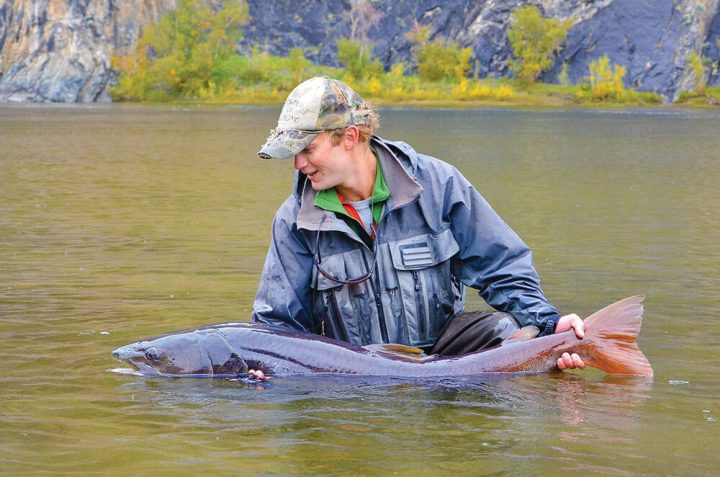
Big western trout are fun. Salmon fishing in Alaska can be an epic adventure. But if you want to do battle with the biggest, most ferocious salmonid in the world, you’ll need to book passage to Mongolia, where the rivers are home to the fish of a flyrodder’s dreams… or nightmares.
The Siberian taimen, called “Mongolian terror trout” by National Geographic, is like an enormous trout with a very bad attitude. The IGFA world record is a 92.5-pound fish that stretched the tape to more than 5 feet, and it is said they can grow much larger. This, however, is not the norm. Most taimen caught by anglers run 20 to 30 inches and weigh between 6 and 15 pounds.
Dan Bailey, with Fish Mongolia and Mongolia River Outfitters, said they consider a fish over 40 inches a trophy. Once taimen reach about 36 inches, they begin to bulk up. This is when they lose their snaky appearance and become true heavyweights. A fish in the 20-, 30-, 40-pound range or larger is always a possibility. And that is an extremely formidable fish, especially considering the violent behavior these fish display.
For a little perspective, there is a Mongolian folk story about a group of starving herders who survived winter by feeding on pieces of an enormous taimen trapped in river ice. When the ice thawed in spring, that fish tracked down the herders, massacred and ate them all.
They are voracious predators. Fish, ducks, mammals foolish enough to go for a swim, even smaller taimen are on the menu. This makes taimen a spectacular gamefish. A 6-inch streamer might be a good choice of fly, but why fish subsurface for a creature that will chase down and destroy a duckling? Short of blitzing bluefin, this could be the most exciting topwater action there is; it definitely takes that prize for freshwater species.
Bailey said they have developed topwater flies that are lightweight yet cause a lot of surface disturbance. Imagine chugging a large popper across a pool similar to what you’d find on a big Western freestone. An enormous head bulges the surface in pursuit before 4 feet of olive-brown muscle explodes from the water, going completely airborne and landing with a crash that jolts your rod arm. There’s the hook set, and then the fight. It might streak across the shallows to bore into deeper water. It might tail-walk across the hole, shaking its head to throw the fly. Taimen have several tricks they’ll employ to get free, but rest assured it will be violent.
Taimen fishing is not an adventure suited to anglers content to soak bait or sit in a boat watching trolling rods. Whether from a drift boat, jet boat or on foot, casting a 9-weight fly rod for 10 straight days is hard work. But the rewards can be enormous. Bailey said they average 150 taimen a week between eight anglers and countless catches of other species. Anglers can also expect to catch Amur pike, Amur trout, lenok, and grayling.
The giant taimen, however, populate the rivers more sparsely, and they are smart. As the apex predators in the systems they inhabit, they can live upwards of 50 years. They spend their entire life cycles in rivers seemingly too small to harbor such creatures. Old well-traveled fish just don’t fall for every fly presented.
International anglers are also saddled with fly fishing only, single barbless hook only regulations by the Mongolian government, and of course catch and release is mandatory. The outfitters don’t seem to mind, though. Conservation is a big deal among the few who have some of the 200 permits issued each year. Conservation is absolutely necessary for a fish that doesn’t reach sexual maturity until 7 years of age. This is witnessed by taimen being fished nearly to extinction over much of its original home range in northern Asia.
For us, it leaves Mongolia as the world’s top taimen destination. And as you’d expect, it comes with a pretty hefty price tag. All-in, anglers traveling from the United States should expect to pay $8,000 or more to have outfitters take them fishing and camping. If you’ve got the money to do it, it is the adventure of a lifetime.
For information, contact Dan Bailey at dan@fishmongolia.com or check out their website at fishmongolia.com.
